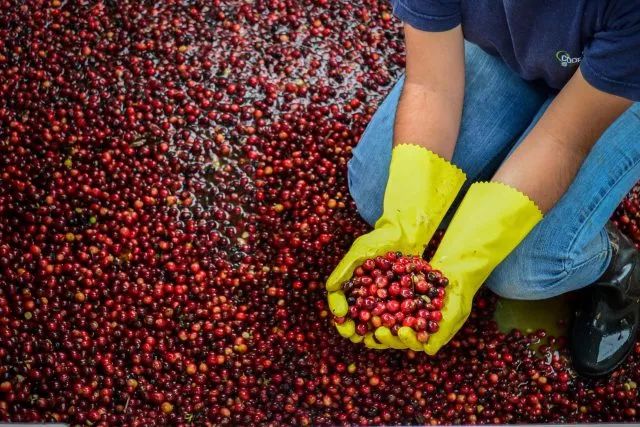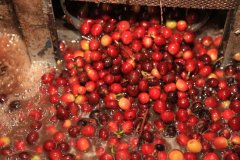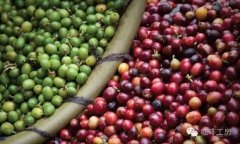How to calculate coffee value scientifically? What kind of coffee is best?

Professional coffee knowledge exchange more coffee bean information please follow the coffee workshop (Wechat official account cafe_style)
The atmosphere of coffee in China is becoming more and more mature, and many specialty coffee shops on the streets emphasize that they sell boutique coffee, but what does the so-called "boutique coffee" represent?
Introduction to boutique coffee
World-class boutique coffee association
Many countries have developed their own boutique coffee associations, and China is no exception, but for baristas all over the world, there are two associations that must be acquainted with each other. They offer a variety of courses, testing tests, and so on, to screen the quality of coffee. Many baristas will also work hard with the goal of getting an association license.
American Fine Coffee Association (SCAA): founded in 1982, belongs to the American system, is the world's most prestigious international coffee association, to brew coffee "in line with the expectations of guests" as the guide.
European Fine Coffee Association (SCAE): founded in 1988, it belongs to the European system, composed of colleagues who seek the ultimate quality of coffee, and is recognized by the government. In a "scientific way", actuarial coffee has become a world-renowned international organization.
The definition of boutique coffee
What is a cup of "boutique coffee"? The definition given by SCAA and SCAE: the association believes that a cup of boutique coffee does not just refer to the cup of coffee that has been brewed and delivered to the mouth of consumers, but emphasizes the whole process of producing the cup of coffee, from farmers, raw bean sellers, roasters who roast raw beans, bakers who brew coffee to consumers who finally taste the flavor, all play an important role in making a cup of premium coffee.
However, coffee expert Lin Huan also mentioned that the association's strict definition of a cup of coffee not only promotes high-quality coffee, but also produces a lot of related license courses. Therefore, a cup of coffee can be called boutique coffee if it can trace the production history of its coffee beans, consumers feel good and meet the C / P value expected in their hearts.
So coffee lovers do not have to take coffee tasting as seriously as an "exam". They can find the most perfect boutique coffee fun between "understand" and "do not understand" the definition of coffee.
Enjoy the cup of coffee in front of you! (Pixabay)
Esselsa species
Ethel sa is a variety discovered in 1904, which is native to the Charlie River Basin in Africa, with small fruit and high yield per plant, especially a drought-resistant variety. The product has a strong flavor, slightly bitter taste and less cultivation.
Typica: the oldest native variety in Ethiopia, all Arabica are derived from Tibica. The top leaf of Tiebika is bronzed and the bean body is oval or thin in shape; the flavor is elegant, but the physique is weak, the disease resistance is poor and the fruit yield is less. Excellent manor beans such as the Blue Mountains of Jamaica, Manning of Sumatra and Kona of Hawaii all belong to Tibika. One of the characteristics is that the top leaf of Tibica is bronzed.
Bourbon: a variant of the early (prehistoric coffee) Tibika that changed its shape from thin to round after it was transplanted to Yemen. It was named bourbon in 1715 after France transplanted round beans from Yemeni mocha to the island of Bourbon on the east coast of Africa (renamed Reunion after the French Revolution). Bourbon beans spread to Brazil and Central and South America in 1727, and the British transplanted Yemeni mochas to St. Helena Island (where Napoleon was later imprisoned) in 1732. Bourbon is the winner of the American boutique coffee cup test.
[gene mutant]
Pointed Bourbon (Bourbon Pointu): found in Bourbon Island in 1810, beans changed from round to pointed, with only half the caffeine content, but in small amounts, weak and extremely precious (mostly cultivated in the laboratory).
Elephant bean (Maragogype, or Elephant Bean): Tibica's best-known variety of beans, first discovered in 1870 in the Maragogype bean-producing region of the state of Bahia in northeastern Brazil, is at least three times larger than the average Arabica, hence the name. The taste of elephant bean is poor in low altitude area, but it has better flavor at high altitude, mild sour taste and sweet fragrance. (the right side of the picture is like beans)
Geisha / Geisha: a derivative of the Tibika family, it was exported from the Geisha Mountains of southern Ethiopia in 1931 (Geisha is synonymous with Japanese geisha). It was unknown in many countries and was transplanted to Panama in the 1960s and did not begin to win cup tests until 2005.
Kenyan "SL28" and "SL34": the bourbon line, screened and cultivated by French and British missionaries and researchers in Kenya in the early 20th century, has adapted to Kenya's high-concentration phosphate soil for a century, giving birth to Kenyan characteristics of sour elves; top Kenyan coffee comes from these two varieties, but it loses its flavor when transplanted elsewhere.
Yellow bourbon (Bourbon Amarello, or YellowBourbon): a bourbon variety endemic to the Brazilian state of Sao Paulo, where the coffee fruit does not turn red and is orange when ripe. It was later found that the pericarp of other local bourbon-derived varieties also turned yellow.
Kaddura (Caturra)
It is a single gene variant of bourbon found in Brazil in the 1950s. It has better yield and disease resistance than bourbon, and the tree is shorter and easy to harvest. Unfortunately, it has the same problem as bourbon-- as a result, it takes a year off for a year. The flavor is equal to or slightly worse than bourbon beans.
But it is more adaptable, can be planted with high density, does not need shade trees, and can be vibrant in direct exposure to the sun, so it is also called "exposed coffee" (Sun Coffee).
Kaddura is suitable for high altitude areas from 700m to 1700 m, but the higher the altitude is, the better the flavor is, and the bean yield is relatively reduced. There are also variants of yellow Kaddura in Central and South America, but the wind rating is not as good as Huang bourbon.
Pacas (Pacas): a bourbon variety found in El Salvador. In 1935, the Salvadoran coffee farmer "Don Alberto Pacas" selected a high-capacity San Ramon bourbon variety to be planted on a farm. In 1956, his coffee tree yielded more fruit than the same kind of coffee tree. Professor "Dr. William Cogwill" of the University of Florida identified this as a genetic mutation in bourbon and named it "Pacas".
Pacas, with its high output and good quality, is popular in Central America. Currently, 68% of El Salvador is bourbon, while Pacas has 29%.
Vera Saatchi (Villa Sarchi): the bourbon variety, first discovered in Costa Rica in the 1960s, has often appeared on the cup test list of excellence in recent years. This is a rare variety bred through the cross of red bourbon tree species. Strong wind resistance, preference for high altitude environment, excellent acidity and a variety of fruit aromas, high sweetness, bright and delicate citrus acidity and low raisin and nut aromas, high complexity and full balance.
Kona: although planted at an altitude of several hundred meters, Kona from the Big Island of Hawaii, with a mild sea breeze and rich volcanic soil, has an incomparably clean acidity and sweetness. Compared with the blue mountains with higher elevations, it is even worse.
Blue Mountain (BlueMountain): blue Mountain, which is popular all over the world and hard to get a bean, comes from the iron pickup family. Why is Blue Mountain so hot and expensive?! It is mostly because it is contracted by the royal army, and partly because it is not satisfied with soil and water and is in poor condition once it leaves Jamaica. After two hundred years of domestication, Blue Mountain has evolved successfully in Jamaica, and its resistance to fruit rot is better than that of ordinary iron pickups.
[Arabica intraspecific hybridization] (Intraspecific Hybrid)
New World (Mundo Novo): a natural cross between Bourbon and Sumatra Tibica, first found in Brazil. Because of its high yield and resistance to diseases and insect pests, it was widely planted in Brazil in the 1950s and was praised as the new hope of the Brazilian coffee industry, but the trees were tall and difficult to harvest.
Catuai: Kaduai is a hybrid of New World and Kaddura. It inherits the advantage of Kaddura's low stature and makes up for the weakness of Arabica fruit. The result is solid, and it is not easy to fall when the strong wind blows. The biggest regret is that its overall flavor is slightly more monotonous than Kadura.
Kaduai also has the difference between red fruit and yellow fruit, and red fruit wins more often than yellow fruit. Kaduai, Kaddura, New World and bourbon are the four main varieties of coffee in Brazil.
Pacamara: a hybrid between Pacas (Pacas) and elephant bean (Maragogype), with a large bean body, second only to elephant bean, is an excellent variety produced in El Salvador in the 1950s, and has achieved good results in cup test in recent years.
Kent: the Tibica hybrid found in India has high yield and strong disease resistance, but has not achieved good results in the cup test.
Hybrid between Arabica and Robbosa bean (Interspecific Hybrid)
Timor: a natural hybrid found in East Timor, an island nation at the eastern end of the Nusa Tenggara Islands, with 44 chromosomes close to Arabica, but with a mediocre flavor, low sour taste and lack of characteristics, it is often used as a low-cost formula bean in Taiwan. However, East Timor also has high-altitude pure Tibica treated with water. Before buying, it is important to find out whether it is a hybrid or a purebred iron card water washed beans, the quality of the two is very different, the former is mediocre, and the latter is amazing.
Catimor: in 1959, the Portuguese mixed Brazilian Kaddura and Timo and bred the second generation of Cartimo, which had strong disease resistance and yield capacity. But the flavor is also poor, and it is an important variety of commercial beans at present. In recent years, botanists from all over the world have turned to the interbreeding of Arabica and Katimodo belts in an attempt to reduce the pedigree of radish beans in order to improve the bad reviews of the Katimo Cup.
Icatu: a Brazilian variety that has been improved for many generations and has been in the top ten of Brazil's Outstanding Cup. In the past, Arabica mixed with turnip beans Arabusta "Arabusta", although increased yield and disease resistance, but the coffee flavor has not been good. Scientists crossed Arabica varieties with Arabica varieties such as Kaddura, New World and Bourbon for many generations, which gradually reduced the bad smell of radish beans and improved the aroma of Arabica beans, thus giving birth to an excellent variety of multi-generation hybrids-Icato.
Ruyilu 11 (Ruiru 11): a hybrid variety developed in Kenya in 1985 with heavy yield and low quality. There are no varieties of Arabica and sturdy beans that can be regarded as boutique coffee so far, so they are not available in many suppliers that specialize in freshly roasted boutique coffee, such as fresh. However, even many imported specialty coffee suppliers mix the hybrid beans with Blend to reduce costs. From the above-mentioned gene mutants (whether natural or scientific products), their flavor has a lot to do with specific geographical conditions.
END
Important Notice :
前街咖啡 FrontStreet Coffee has moved to new addredd:
FrontStreet Coffee Address: 315,Donghua East Road,GuangZhou
Tel:020 38364473
- Prev

What is the definition of scaa boutique coffee concept? What is the best variety of boutique coffee?
Professional coffee knowledge exchange more coffee bean information Please follow Coffee Workshop (Wechat official account cafe_style) Coffee originated in Ethiopia and was originally grown in a few countries in Africa and the Middle East. It was rapidly spread to the whole world in the 18th century, which was directly related to the rise of European powers and the invasion and occupation of colonies. In 1982, SCAA (American essence)
- Next

Scaa Fine Coffee concept definition is there a relationship between coffee varieties and boutique coffee?
Professional coffee knowledge exchange more coffee bean information please follow the coffee workshop (Wechat official account cafe_style) boutique coffee Specialty Coffee 1974 Ms. Erna Knutsen of the United States proposed the term boutique coffee Specialty Coffee in the magazine Coffee and Tea. At that time, Ms. Knudsen worked as a coffee at B.C. Ireland in San Francisco.
Related
- Detailed explanation of Jadeite planting Land in Panamanian Jadeite Manor introduction to the grading system of Jadeite competitive bidding, Red bid, Green bid and Rose Summer
- Story of Coffee planting in Brenka region of Costa Rica Stonehenge Manor anaerobic heavy honey treatment of flavor mouth
- What's on the barrel of Blue Mountain Coffee beans?
- Can American coffee also pull flowers? How to use hot American style to pull out a good-looking pattern?
- Can you make a cold extract with coffee beans? What is the right proportion for cold-extracted coffee formula?
- Indonesian PWN Gold Mandrine Coffee Origin Features Flavor How to Chong? Mandolin coffee is American.
- A brief introduction to the flavor characteristics of Brazilian yellow bourbon coffee beans
- What is the effect of different water quality on the flavor of cold-extracted coffee? What kind of water is best for brewing coffee?
- Why do you think of Rose Summer whenever you mention Panamanian coffee?
- Introduction to the characteristics of authentic blue mountain coffee bean producing areas? What is the CIB Coffee Authority in Jamaica?

